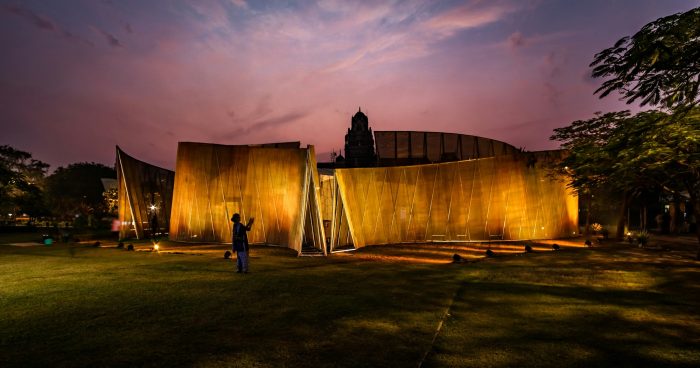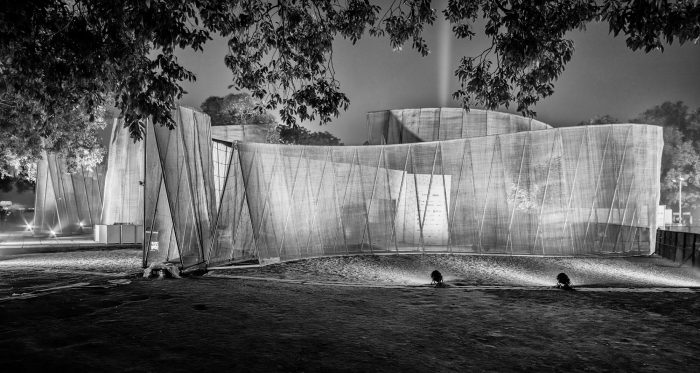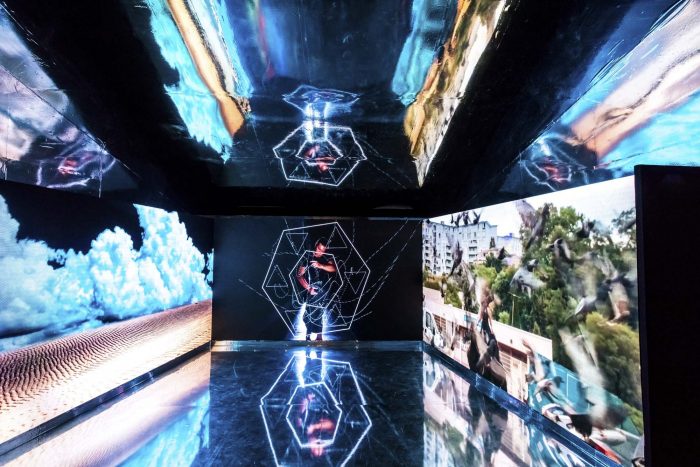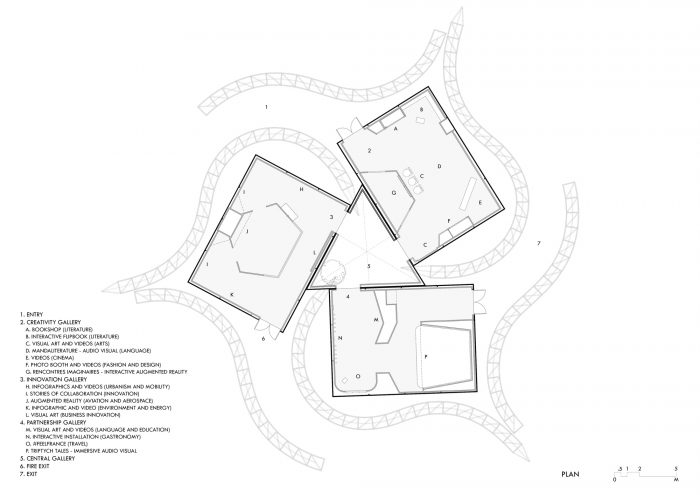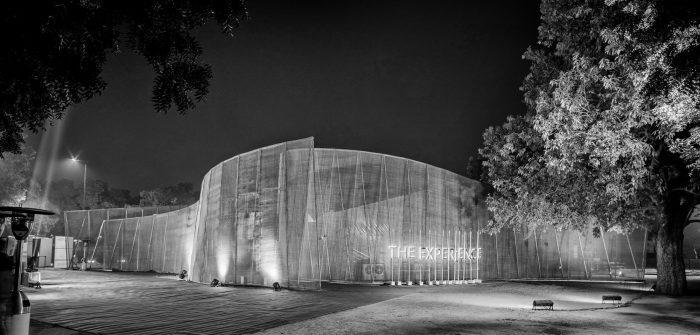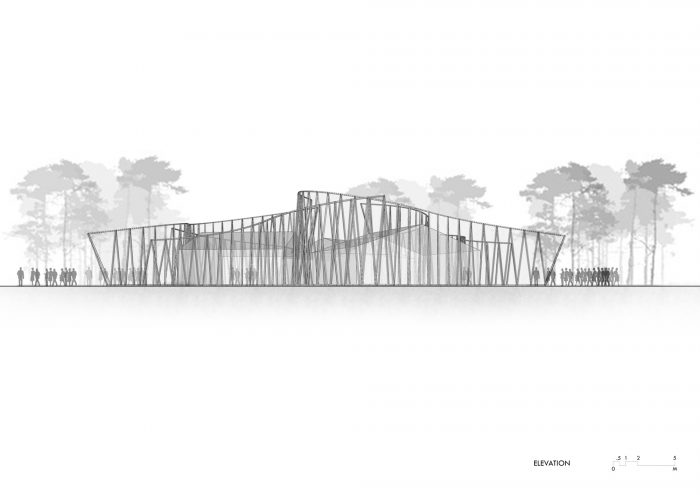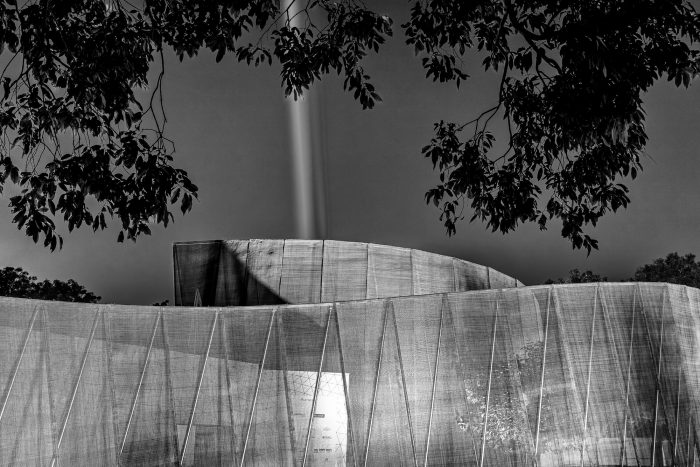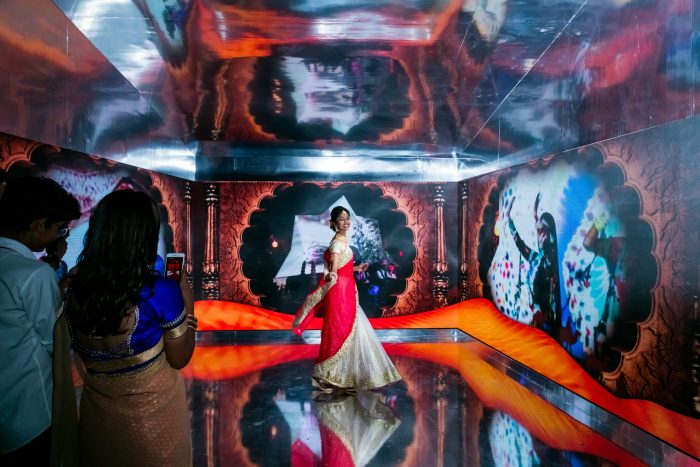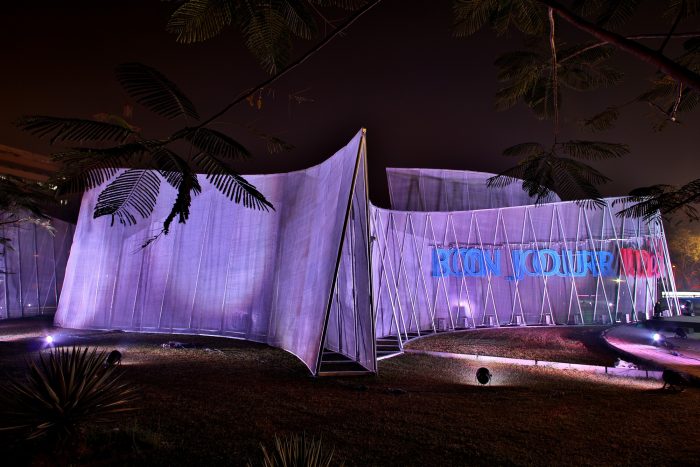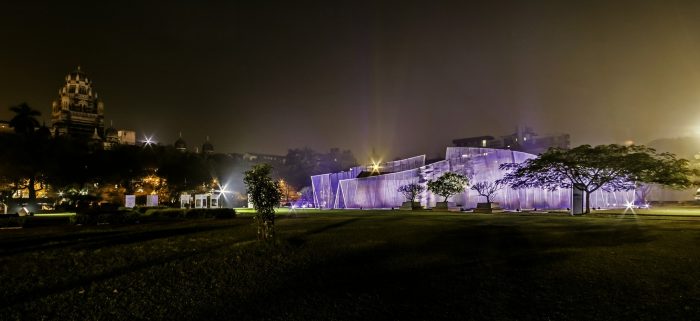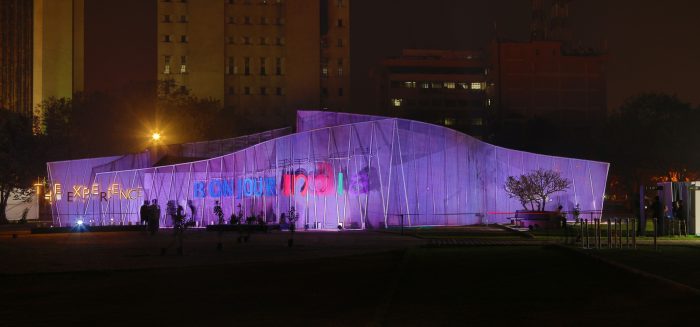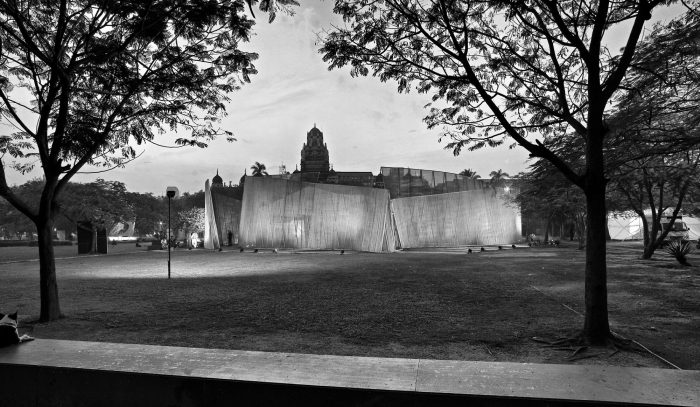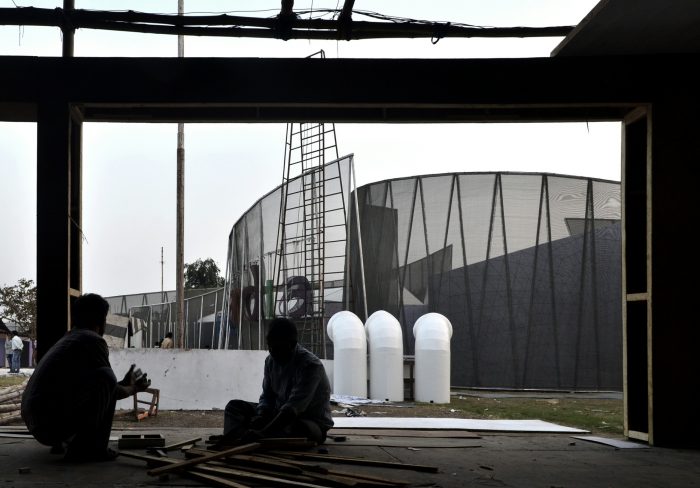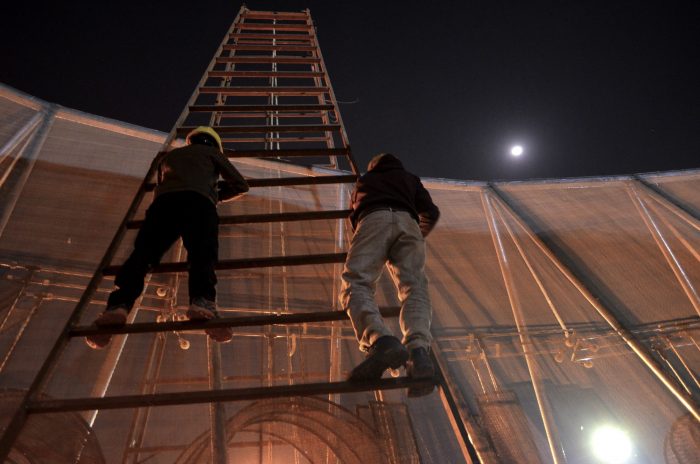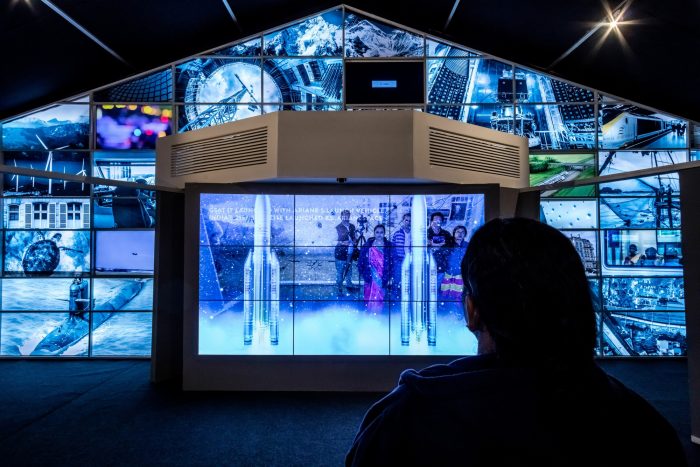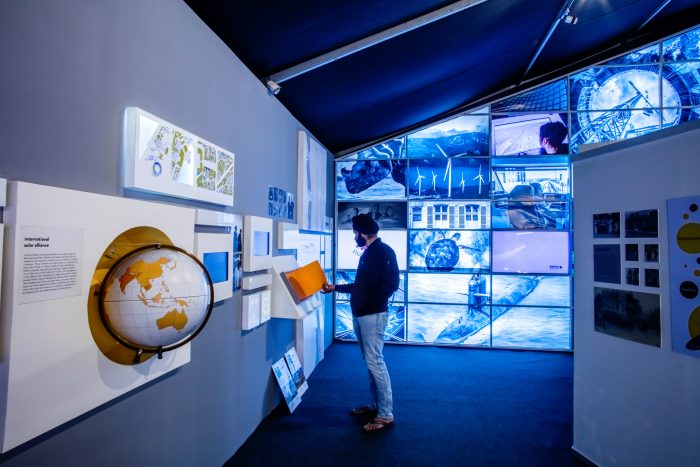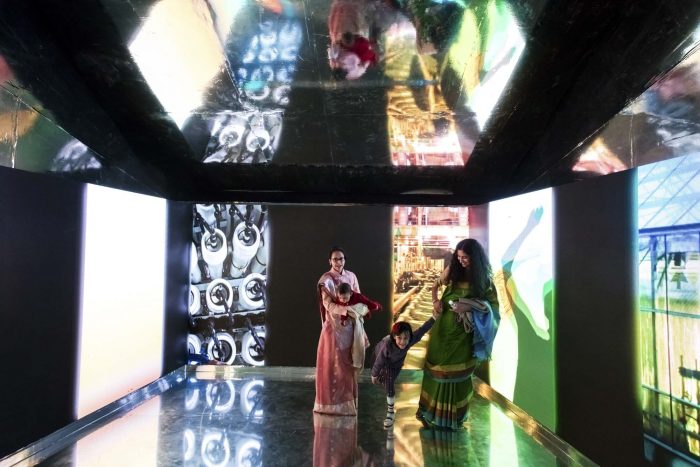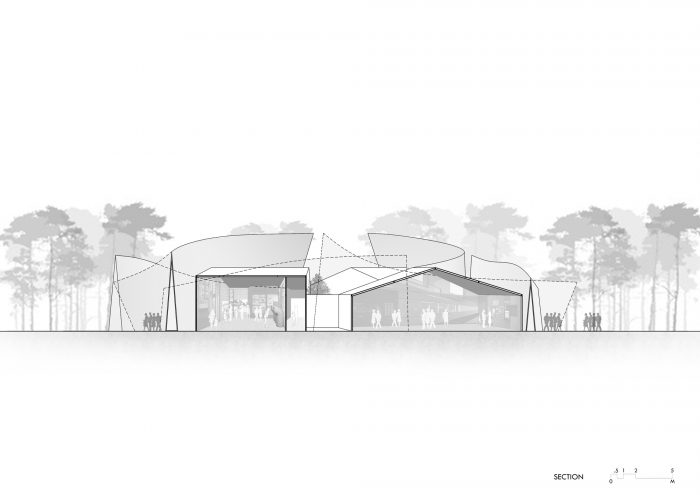Bonjour India Experience」是「Bonjour India 2017-2018」的旗舰举措,这个节日通过遍布印度33个城市的300多场活动,庆祝印法合作。作为艺术节的核心,”Bonjour India Experience “展馆是一个独一无二的艺术、建筑、设计和城市主义交叉的巡回展览。这个高9米、面积800平方米、重达40吨的装置,从德里标志性的印度门到孟买历史悠久的Churchgate车站后面的Cross Maidan花园,行程约3500公里,成为加尔各答世界最大书展的明星景点,历时三个月。在30多天的时间里,它迎来了超过18万名游客,分布在三个城市。
The ‘Bonjour India Experience’ was the flagship initiative of the Bonjour India 2017-2018, a festival which celebrated Indo-French collaborations through more than 300 events spread over four months across 33 Indian cities. At the heart of the festival, The Bonjour India Experience pavilion was a one-of-its-kind travelling exhibition at the intersection of art, architecture, design and urbanism. The 9 meter high, 800 square metre and 40 tonne installation travelled approx. 3500 kilometres from the iconic India Gate in Delhi to Cross Maidan Garden behind the historic Churchgate Station Mumbai to become the star attraction of the world’s largest book fair in Kolkata over a period three months. It welcomed more than 180,000 visitors over a period of 30 odd days spread over the three cities.
客户和SpaceMatters领导的设计团队共同做出的第一个决定是将展馆设在城市公共空间。虽然这似乎是一个显而易见的选择,但在印度,类似的文化活动大多局限于博物馆和文化中心等机构空间。这些空间往往被认为是精英主义的,它们只满足一小部分人的需求,其氛围与印度城市公共空间的多元活力形成了鲜明的对比。随着文化活动退缩到门禁区,印度城市公共空间的使用权也在不断缩小,越来越多地被管制和货币化。因此,当被要求建议在他们的城市中寻找一个合适的公共空间时,联想到最初建议的是商业商场!而当被要求在印度的城市中寻找一个合适的公共空间时,联想到的是商业商场。将展馆设在真正的城市公共空间的要求带来了无数的挑战,在公共场所安装这种规模的装置所需的各种许可是一项复杂的工作。然而,它与城市环境的互动成为了该馆的决定性特征,并对其成功起到了关键作用。
One of the first decisions jointly taken by the clients and the design team lead by SpaceMatters was to locate the pavilion in public urban spaces. While this may seem like an obvious choice, similar cultural events in India have been largely confined to institutional spaces such as museums and cultural centres. Often perceived as elitist, these spaces cater to a small segment of the population and their ambience is in stark contrast to the diverse energy of the urban public space in Indian cities. As cultural events retreat into gated zones the access to public space in Indian cities is also shrinking, increasingly being policed and monetised. Thus, when asked to suggest an appropriate public space in their city, associates initially suggested commercial malls! The call to locate the pavilion in truly public urban spaces presented countless challenges and it was a complex undertaking to navigate the maze of permissions needed to mount an installation of this scale in a public location. However, its interaction with the urban context became the defining characteristic of the pavilion and was instrumental to its success.
设计必须平衡旅行馆的功能需求和密封展览空间的严格要求,要求安全地容纳昂贵的视听设备,同时为参观者创造一个舒适的环境。展馆的设计必须在一周内完成安装,并在拥挤的公共空间内三天内完成拆除,而不需要使用重型机械(高安全级别的场所禁止使用);同时还要方便地穿越半个国家并适应新的场所。为了调和展馆的移动性和时间性,同时也为了给所到城市留下一个难忘的印记,展馆必须创造一个标志性的视觉存在,并结合轻盈的感觉。
The design had to balance the functional demands of a travelling pavilion with the stringent requirements of a sealed exhibition space required to safely house expensive audio visual equipment while creating create a comfortable environment for the visitors. The pavilion had to be designed to be installed in a week and dismantled in three days in crowded public spaces without the use of heavy machinery (prohibited at the high security sites); with the ease of travelling halfway across the country and adapting to new sites. To reconcile the mobile and temporal nature of the pavilion alongside the ambition to leave a memorable mark on the cities it travelled to, the pavilion had to create an iconic visual presence combined with a lightness of being.
Bonjour印度节的主题重点是印度和法国之间的 “创意、创新和伙伴关系”。体现这些主题,展馆的形式由汇合的概念演变而来,6条曲线共同上升,拥抱三个展馆,突出印法创意、创新与伙伴关系的各个方面。金属曲线以模块对称的方式从中央核心螺旋状排列,由错落有致的自支撑钢构件和2万平方英尺的手工编织钢网组成。巨大的自支撑结构设计到最后一个连接点都是平铺直叙,并在最短的时间内进行手工安装。结合尖端工程的精确性和独特的工艺表达,该设计向法国和印度建筑的独创性和抽象性致敬。
The thematic focus of the Bonjour India festival was ‘Creativity, Innovation and Partnership’ between India and France. Embodying these themes, the form of the pavilion evolved from the idea of confluence, with 6 curves rising together to embrace three pavilions that highlight various aspects of Indo-French creativity, innovation & partnership. The metal curves, arranged in a modular symmetry spiralling out from a central core, consisted of a rhythmic arrangement of staggered, self-supporting steel members draped with 20,000 square feet of hand woven steel mesh. The massive self-supporting structure is designed down to the last joint to be flat packed and largely hand installed in the shortest possible time. Combining the precision of cutting edge engineering and unique expression of craft, the design pays homage to the ingenuity and abstraction that is the hallmark of both French and Indian architecture.
作为对公共空间的干预,亭子的设计与每个地点的场地条件相融合。金属构件和网状结构提供了不同层次的视觉渗透性,使结构与城市环境交织在一起,既从环境中出现,又与环境融为一体。每个地点的标志性纪念物,如德里的印度门和孟买的Churchgate铁路总站,都被定格在结构轮廓和金属网的分层轮廓中。随着白天和黑夜的光影变化,亭子的螺旋形成为一个枢纽,重新组织了城市开放区域的性质,同时提高了外面的人对内部探索的好奇心。亭子的雕塑造型在4米到9米的高度上起起伏伏,当游客绕着亭子走,走进亭子时,亭子的造型也随之发生变化。
As an intervention in public space the pavilion is designed to integrate itself with the site conditions at each location. The metal members and mesh provide for varying gradations visual permeability, allowing the structure to weave into the urban surroundings, both emerging from and merging into the context. Views of iconic monuments at each site, such as the India Gate in Delhi and the Churchgate Railway Terminus in Mumbai are framed within the layered silhouette of the structural contours and wire mesh.As the pavilion transforms with the play of light through day and night, its spiralling form becomes the pivot which reorganises the nature of the urban open area while heightening curiosity amongst those outside to explore within. Twisting and turning, rising and falling from a height of 4 metres to 9 metres across its perimeter, the sculptural form of the pavilion transforms with motion as the visitors walk around it and into it.
建筑师:SpaceMatters
面积:8000平方英尺
年份:2018年
摄影:Hermant Chawla, Nishita Mohta, Achint Jain
厂家: 3M, Asian Paints, Diakin, Losberger, Nilaya, Samsung
Execuring Agency (External Pavillion):RK Engineering
执行机构(外部展馆):RK Engineering
执行机构(展览):Paras Art Studio
视听设备:Shivam Video
合作伙伴:Institut Francais en Inde, The French Embassy in Delhi, Institut Francaise de Bombay, Institut Francaise de Delhi , Institut Franciase du Bengale
内容创作合作者:Rajat Nanda, Achint Jain, Vivan Kamath, Moulshri Joshi
装置合作方:Ant Studio – Dynamic Signage Installation, Scenocosme – Rencontres Imaginaires Installation Art, Mosquito Massala –- MandLiterature, Tryptich Tales Video Installation Art, TaggLabs.
内容合作伙伴:Agence Française de Développement, Air France, ATA Architects, Archives SONUMA, Arianespace, Association des Amis de Lanza del Vasto, Atout France, Campus France, Chanakya International, Château de Versailles, Consulat Général de France à Pondichéry, Core Econ, DC Books, Diane de Selliers, Fata Morgana Editions, FIND Foundation, Fondation Le Corbusier, Fondation Pierre Bergé – Musée Yves Saint Laurent Paris, Full Circle Publishing, Green Books, La Fondation Louis Vicat, Lesage Interieurs, Malraux.org, Mapin Publishing, Musée Goupil – Bordeaux, Neemrana Music Foundation, Om Books, SNCF Group, the Raza Foundation, Institut Lumière, Gallimard, Institut français de Pondichéry, Niyogi Books, Rajpal & Sons, Seagull Books, Tata Central Archives, Thadagam Publishers, Vani Prakashan, Veolia, Warum Publishers, Young Zubaan,Dualist Inquiry, Chinese Man, Nirmal Sapera, Talab Khan Barna, Lucid Raaga, Talab Khan Barna , Ahmad Zahir, Viveick Rajagopalan & Naviin Gandharv .
客户:Institut Français en Inde, The Embassy of France , India
主要建筑师:Amritha Ballal, Suditya Sinha
项目建筑师:Divya Manaktola, Nishita Mohta
建筑师团队:Gaurav Gupta, Sony Joshua, Pulkit Mogha, Devansh Mahajan, Sandeep Singh Rathore, Girisha Sethi, Akhilesh Yadav
城市:新德里
国家:印度
Architects: SpaceMatters
Area: 8000 ft²
Year: 2018
Photographs: Hermant Chawla, Nishita Mohta, Achint Jain
Manufacturers: 3M, Asian Paints, Diakin, Losberger, Nilaya, Samsung
Execuring Agency (External Pavillion):RK Engineering
Executing Agency (Exhibition):Paras Art Studio
Audiovisual Equipment:Shivam Video
Partners:Institut Francais en Inde, The French Embassy in Delhi, Institut Francaise de Bombay, Institut Francaise de Delhi , Institut Franciase du Bengale
Content Creation Collaborators:Rajat Nanda, Achint Jain, Vivan Kamath, Moulshri Joshi
Installation Collaborators:Ant Studio – Dynamic Signage Installation, Scenocosme – Rencontres Imaginaires Installation Art, Mosquito Massala –- MandLiterature, Tryptich Tales Video Installation Art, TaggLabs.
Content Partners:Agence Française de Développement, Air France, ATA Architects, Archives SONUMA, Arianespace, Association des Amis de Lanza del Vasto, Atout France, Campus France, Chanakya International, Château de Versailles, Consulat Général de France à Pondichéry, Core Econ, DC Books, Diane de Selliers, Fata Morgana Editions, FIND Foundation, Fondation Le Corbusier, Fondation Pierre Bergé – Musée Yves Saint Laurent Paris, Full Circle Publishing, Green Books, La Fondation Louis Vicat, Lesage Interieurs, Malraux.org, Mapin Publishing, Musée Goupil – Bordeaux, Neemrana Music Foundation, Om Books, SNCF Group, the Raza Foundation, Institut Lumière, Gallimard, Institut français de Pondichéry, Niyogi Books, Rajpal & Sons, Seagull Books, Tata Central Archives, Thadagam Publishers, Vani Prakashan, Veolia, Warum Publishers, Young Zubaan,Dualist Inquiry, Chinese Man, Nirmal Sapera, Talab Khan Barna, Lucid Raaga, Talab Khan Barna , Ahmad Zahir, Viveick Rajagopalan & Naviin Gandharv .
Client:Institut Français en Inde, The Embassy of France , India
Principal Architects:Amritha Ballal, Suditya Sinha
Project Architects:Divya Manaktola, Nishita Mohta
Team Architects:Gaurav Gupta, Sony Joshua, Pulkit Mogha, Devansh Mahajan, Sandeep Singh Rathore, Girisha Sethi, Akhilesh Yadav
City:New Delhi
Country:India


